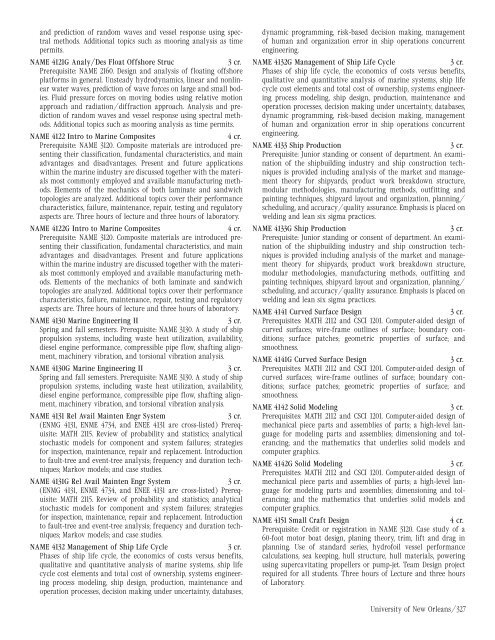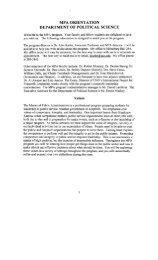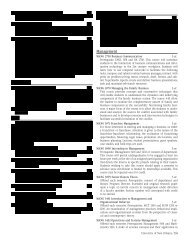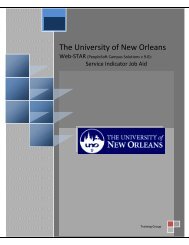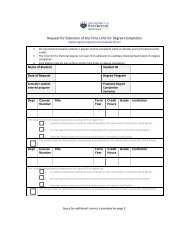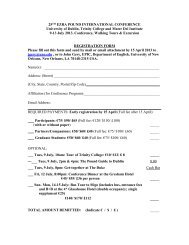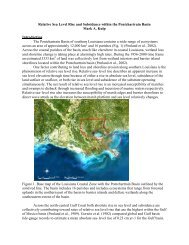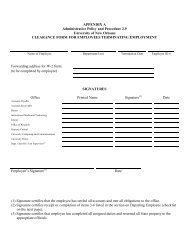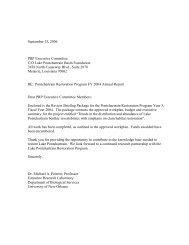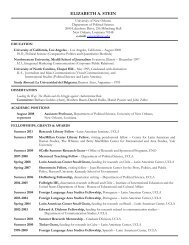Untitled - University of New Orleans
Untitled - University of New Orleans
Untitled - University of New Orleans
Create successful ePaper yourself
Turn your PDF publications into a flip-book with our unique Google optimized e-Paper software.
and prediction <strong>of</strong> random waves and vessel response using spectral<br />
methods. Additional topics such as mooring analysis as time<br />
permits.<br />
NAME 4121G Analy/Des Float Offshore Struc<br />
3 cr.<br />
Prerequisite: NAME 2160. Design and analysis <strong>of</strong> floating <strong>of</strong>fshore<br />
platforms in general. Unsteady hydrodynamics, linear and nonlinear<br />
water waves, prediction <strong>of</strong> wave forces on large and small bodies.<br />
Fluid pressure forces on moving bodies using relative motion<br />
approach and radiation/diffraction approach. Analysis and prediction<br />
<strong>of</strong> random waves and vessel response using spectral methods.<br />
Additional topics such as mooring analysis as time permits.<br />
NAME 4122 Intro to Marine Composites<br />
4 cr.<br />
Prerequisite: NAME 3120. Composite materials are introduced presenting<br />
their classification, fundamental characteristics, and main<br />
advantages and disadvantages. Present and future applications<br />
within the marine industry are discussed together with the materials<br />
most commonly employed and available manufacturing methods.<br />
Elements <strong>of</strong> the mechanics <strong>of</strong> both laminate and sandwich<br />
topologies are analyzed. Additional topics cover their performance<br />
characteristics, failure, maintenance, repair, testing and regulatory<br />
aspects are. Three hours <strong>of</strong> lecture and three hours <strong>of</strong> laboratory.<br />
NAME 4122G Intro to Marine Composites<br />
4 cr.<br />
Prerequisite: NAME 3120. Composite materials are introduced presenting<br />
their classification, fundamental characteristics, and main<br />
advantages and disadvantages. Present and future applications<br />
within the marine industry are discussed together with the materials<br />
most commonly employed and available manufacturing methods.<br />
Elements <strong>of</strong> the mechanics <strong>of</strong> both laminate and sandwich<br />
topologies are analyzed. Additional topics cover their performance<br />
characteristics, failure, maintenance, repair, testing and regulatory<br />
aspects are. Three hours <strong>of</strong> lecture and three hours <strong>of</strong> laboratory.<br />
NAME 4130 Marine Engineering II<br />
3 cr.<br />
Spring and fall semesters. Prerequisite: NAME 3130. A study <strong>of</strong> ship<br />
propulsion systems, including waste heat utilization, availability,<br />
diesel engine performance, compressible pipe flow, shafting alignment,<br />
machinery vibration, and torsional vibration analysis.<br />
NAME 4130G Marine Engineering II<br />
3 cr.<br />
Spring and fall semesters. Prerequisite: NAME 3130. A study <strong>of</strong> ship<br />
propulsion systems, including waste heat utilization, availability,<br />
diesel engine performance, compressible pipe flow, shafting alignment,<br />
machinery vibration, and torsional vibration analysis.<br />
NAME 4131 Rel Avail Mainten Engr System<br />
3 cr.<br />
(ENMG 4131, ENME 4734, and ENEE 4131 are cross-listed) Prerequisite:<br />
MATH 2115. Review <strong>of</strong> probability and statistics; analytical<br />
stochastic models for component and system failures; strategies<br />
for inspection, maintenance, repair and replacement. Introduction<br />
to fault-tree and event-tree analysis; frequency and duration techniques;<br />
Markov models; and case studies.<br />
NAME 4131G Rel Avail Mainten Engr System<br />
3 cr.<br />
(ENMG 4131, ENME 4734, and ENEE 4131 are cross-listed) Prerequisite:<br />
MATH 2115. Review <strong>of</strong> probability and statistics; analytical<br />
stochastic models for component and system failures; strategies<br />
for inspection, maintenance, repair and replacement. Introduction<br />
to fault-tree and event-tree analysis; frequency and duration techniques;<br />
Markov models; and case studies.<br />
NAME 4132 Management <strong>of</strong> Ship Life Cycle<br />
3 cr.<br />
Phases <strong>of</strong> ship life cycle, the economics <strong>of</strong> costs versus benefits,<br />
qualitative and quantitative analysis <strong>of</strong> marine systems, ship life<br />
cycle cost elements and total cost <strong>of</strong> ownership, systems engineering<br />
process modeling, ship design, production, maintenance and<br />
operation processes, decision making under uncertainty, databases,<br />
dynamic programming, risk-based decision making, management<br />
<strong>of</strong> human and organization error in ship operations concurrent<br />
engineering.<br />
NAME 4132G Management <strong>of</strong> Ship Life Cycle<br />
3 cr.<br />
Phases <strong>of</strong> ship life cycle, the economics <strong>of</strong> costs versus benefits,<br />
qualitative and quantitative analysis <strong>of</strong> marine systems, ship life<br />
cycle cost elements and total cost <strong>of</strong> ownership, systems engineering<br />
process modeling, ship design, production, maintenance and<br />
operation processes, decision making under uncertainty, databases,<br />
dynamic programming, risk-based decision making, management<br />
<strong>of</strong> human and organization error in ship operations concurrent<br />
engineering.<br />
NAME 4133 Ship Production<br />
3 cr.<br />
Prerequisite: Junior standing or consent <strong>of</strong> department. An examination<br />
<strong>of</strong> the shipbuilding industry and ship construction techniques<br />
is provided including analysis <strong>of</strong> the market and management<br />
theory for shipyards, product work breakdown structure,<br />
modular methodologies, manufacturing methods, outfitting and<br />
painting techniques, shipyard layout and organization, planning/<br />
scheduling, and accuracy/quality assurance. Emphasis is placed on<br />
welding and lean six sigma practices.<br />
NAME 4133G Ship Production<br />
3 cr.<br />
Prerequisite: Junior standing or consent <strong>of</strong> department. An examination<br />
<strong>of</strong> the shipbuilding industry and ship construction techniques<br />
is provided including analysis <strong>of</strong> the market and management<br />
theory for shipyards, product work breakdown structure,<br />
modular methodologies, manufacturing methods, outfitting and<br />
painting techniques, shipyard layout and organization, planning/<br />
scheduling, and accuracy/quality assurance. Emphasis is placed on<br />
welding and lean six sigma practices.<br />
NAME 4141 Curved Surface Design<br />
3 cr.<br />
Prerequisites: MATH 2112 and CSCI 1201. Computer-aided design <strong>of</strong><br />
curved surfaces; wire-frame outlines <strong>of</strong> surface; boundary conditions;<br />
surface patches; geometric properties <strong>of</strong> surface; and<br />
smoothness.<br />
NAME 4141G Curved Surface Design<br />
3 cr.<br />
Prerequisites: MATH 2112 and CSCI 1201. Computer-aided design <strong>of</strong><br />
curved surfaces; wire-frame outlines <strong>of</strong> surface; boundary conditions;<br />
surface patches; geometric properties <strong>of</strong> surface; and<br />
smoothness.<br />
NAME 4142 Solid Modeling<br />
3 cr.<br />
Prerequisites: MATH 2112 and CSCI 1201. Computer-aided design <strong>of</strong><br />
mechanical piece parts and assemblies <strong>of</strong> parts; a high-level language<br />
for modeling parts and assemblies; dimensioning and tolerancing;<br />
and the mathematics that underlies solid models and<br />
computer graphics.<br />
NAME 4142G Solid Modeling<br />
3 cr.<br />
Prerequisites: MATH 2112 and CSCI 1201. Computer-aided design <strong>of</strong><br />
mechanical piece parts and assemblies <strong>of</strong> parts; a high-level language<br />
for modeling parts and assemblies; dimensioning and tolerancing;<br />
and the mathematics that underlies solid models and<br />
computer graphics.<br />
NAME 4151 Small Craft Design<br />
4 cr.<br />
Prerequisite: Credit or registration in NAME 3120. Case study <strong>of</strong> a<br />
60-foot motor boat design, planing theory, trim, lift and drag in<br />
planning. Use <strong>of</strong> standard series, hydr<strong>of</strong>oil vessel performance<br />
calculations, sea keeping, hull structure, hull materials, powering<br />
using supercavitating propellers or pump-jet. Team Design project<br />
required for all students. Three hours <strong>of</strong> Lecture and three hours<br />
<strong>of</strong> Laboratory.<br />
<strong>University</strong> <strong>of</strong> <strong>New</strong> <strong>Orleans</strong>/327


